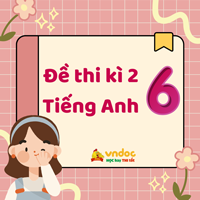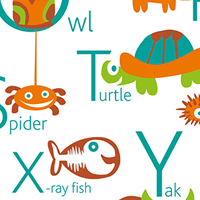Đề thi thử THPT Quốc gia môn Tiếng Anh năm 2018 có đáp án + giải thích chi tiết (Đề số 10)
Đề ôn thi THPT Quốc gia môn tiếng Anh
Mời các bạn vào tham khảo Đề thi thử THPT Quốc gia môn Tiếng Anh năm 2018 có đáp án + giải thích chi tiết (Đề số 10) do VnDoc.com sưu tầm và đăng tải sau đây nhằm đưa đến cho các bạn nguồn ôn tập hữu ích trước khi bước vào kì thi THPT Quốc gia chính thức đang đến. Sau đây mời các bạn vào tham khảo.
ĐỀ THI GỒM 50 QUESTION (TỪ QUESTION 1 ĐẾN QUESTION 50)
Mark the letter A, B, C, or D on your answer sheet to indicate the word that is closest in meaning to the underlined part in each of the following questions.
Question 1. She had no qualms about lying to the police.
A. distress B. impunity C. persevere D. scruple
Question 2. Her impersonations of our teachers were a source of considerable mirth.
A. anger B. glee C. sarcasm D. mistrust
Mark the letter A, B, C, or D on your answer sheet to indicate the word that is opposite in meaning to the underlined part in each of the following questions.
Question 3. I was not dreaming," I said, with some warmth, for her brazen coolness provoked me.
A. bashful B. boisterous C. noisy D. heated
Question 4. Without demur, then, she turned and accompanied the rascally Malay toward the harbour.
A. embrace B. crude C. boisterous D. falter
Mark the letter A, B, C, or D on your answer sheet to indicate the word that differs from the rest in the position of the main stress in each of the following questions.
Question 5. A. vocabulary B. influential C. engineering D. biological
Question 6. A. referee B. electrician C. manufacture D. immortal
Mark the letter A, B, C, or D on your answer sheet to show the underlined part that needs correction
Question 7. A paragraph is a portion of a text consists of one or more sentences related to the same idea.
A B C D
Question 8. Students should be encouraged to discuss critically about the information that they are given.
A B C D
Question 9. Neither of the scout leaders know how to trap wild animals or how to prepare them for mounting.
A B C D
Read the following passage and mark the letter A, B, C or D on your answer sheet to indicate the correct answer to each of the following questions from 10 to 16.
In addition to providing energy, fats have several other functions in the body. The fat soluble vitamins, A, D, E and K, are dissolved in fats, as their name implies. Good sources of these vitamins have high oil or fat content, and the vitamins are stored in the body’s fatty tissues. In the diet, fats cause food to remain longer in the stomach, this increasing the feeling of fullness for some time after a meal is eaten. Fats add variety, taste, and texture to foods, which accounts for the popularity of fried foods. Fatty deposits in the body have an insulating and protective value. The curves of the human female body are due mostly to strategically located fat deposits.
Whether a certain amount of fat in the diet is essential to human health is not definitely known. When rats are fed a fat-free diet, their growth eventually ceases, their skin becomes inflamed and scaly, and their reproductive systems are damaged. Two fatty acids, linoleic and arachidonic acids, prevent these abnormalities and hence are called essential fatty acids. They also are required by a number of other animals but their roles in human beings are debatable. Most nutritionists consider linoleic fatty acid an essential nutrient for humans.
Question 10. This passage probably appeared in which of the following?
A. Adiet book B. A book on basic nutrition
C. Acookbook D. A popular women’s magazine
Question 11. The phrase “stored in” in lines 3 is closest in meaning to__________.
A. manufactured in B. attached to
C. measuredby D. accumulated
Question 12. The author states that fats serve all the following body function EXCEPT to__________.
A. promote a feelingof fullness B. insulate and protect the body
C. provideenergy D. control weight gain
Question 13. According to the author of the passage, which of the following is true for rats when they are fed a fat free diet?
A. Theystop growing B. They have more babies
C. They losebody hair D. They require less care
Question 14. Linoleic fatty acid is mentioned in the passage as__________-.
A. an essential nutrient for humans
B. more useful than arachidonic acid
C. preventing weight gain in rats
D. a nutrient found in most food
Question 15. The phrase “these abnormalities” in line 11 refers to____________.
A. a condition caused by fried food
B. strategically located fat deposits
C. curves on the human female body
D. cessation of growth, bad skin, and damaged reproductive systems
Question 16. That humans should all have some fat in our diet is, according to the author
A. a commonlyheld view B. not yet a proven fact
C. only truefor women D. proven to be true by experiments on rats
Read the following passage and mark the letter A, B, C, or D to indicate the best option for each of the blanks.
From the seeds themselves to the machinery, fertilizers and pesticides - The Green Revolution regimen depend heavily on technology. One (17) _______, however, depends much more on technology - organic farming. Many organic farmers use machinery, but (18)__________ chemical fertilizers or pesticides. (19)_________chemical soil enrichers, they use animal manure and plant parts not used as food - natural, organic fertilizers that are clearly a renewable (20) _________. Organic farmers also use alternatives for pesticides; for example, they may rely (21) natural predators of certain insect pests. Then, the need arises, they can buy the eggs and larvae of these natural predators and introduce them into their crop fields.
Question 17. | A. alternative | B. alternate | C. alteration | D. alternation |
Question 18. | A. also | B. for | C. not | D. all |
Question 19. | A. In spite of | B. On account of | C. In favour of | D. Instead of |
Question 20. | A. resource | B. source | C. matter | D. substance |
Question 21. | A. of | B. to | C. on | D. in |
Read the following passage and mark the letter A, B, C or D on your answer sheet to indicate the correct answer to each of the following questions from 22 to 28.
An air pollutant is defined as a compound added directly or indirectly by humans to the atmosphere in such quantities as to affect humans, animals, vegetation, or materials adversely. Air pollution requires a very flexible definition that permits continuous change. When the first air pollution laws were established in England in the fourteenth century, air pollutants were limited to compounds that could be seen or smelled - a far cry from the extensive list of harmful substances known today. As technology has developed and knowledge of the health aspects of various chemicals has increased, the list of air pollutants has lengthened. In the future, even water vapor might be considered an air pollutant under certain conditions.
Many of the more important air pollutants, such as sulfur oxides, carbon monoxide, and nitrogen oxides, are found in nature. As the Earth developed, the concentration of these pollutants was altered by various chemical reactions; they became components in biogeochemical cycles. These serve as an air purification scheme by allowing the compounds to move from the air to the water or soil. On a global basis, nature's output of these compounds dwarfs that resulting from human activities.
However, human production usually occurs in a localized area, such as a city. In such a region, human output may be dominant and may temporarily overload the natural purification scheme of the cycles. The result is an increased concentration of noxious chemicals in the air. The concentrations at which the adverse effects appear will be greater than the concentrations that the pollutants would have in the absence of human activities. The actual concentration need not be large for a substance to be a pollutant; in fact, the numerical value tells us little until we know how much of an increase this represents over the concentration that would occur naturally in the area. For example, sulfur dioxide has detectable health effects at 0.08 parts per million (ppm), which is about 400 times its natural level. Carbon monoxide, however, has a natural level of 0.1 ppm and is not usually a pollutant until its level reaches about 15 ppm.
Question 22. What does the passage mainly discuss?
A. The economic impact of air pollution.
B. What constitutes an air pollutant.
C. How much harm air pollutants can cause.
D. The effects of compounds added to the atmosphere.
Question 23. It can be inferred from the first paragraph that__________.
A. water vapor is an air pollutant in localized areas
B. most air pollutants today can be seen or smelled
C. the definition of air pollution will continue to change
D. a substance becomes an air pollutant only in cities
Question 24. For which of the following reasons can natural pollutants play an important role in controlling air pollution?
A. They function as part of a purification process.
B. They occur in greater quantities than other pollutants.
C. They are less harmful to living beings than other pollutants.
D. They have existed since the Earth developed.
Question 25. According to the passage, human-generated air pollution in localized regions__________.
A. can be dwarfed by nature's output of pollutants
B. can overwhelm the natural system that removes pollutants
C. will damage areas outside of the localized regions
D. will react harmfully with natural pollutants
Đáp án Đề thi thử THPT Quốc gia môn tiếng Anh năm 2018
Mark the letter A, B, C, or D on your answer sheet to indicate the word that is closest in meaning to the underlined part in each of the following questions.
1. Đáp án: D
- distress (n): sự phiền muộn, buồnrầu
- impunity (n): sự miễntội
- persevere (n): sự bền lòng, kiêntrì
- scruple (n) = qualm (n): sự do dự, ngầnngại
2. Đáp án: B
- anger (n): sự tứcgiận
- glee (n) = mirth (n): sự vui vẻ, hoanhỉ
- sarcasm (n): sự mỉamai
- mistrust (n): sự ngờvực
Mark the letter A, B, C, or D on your answer sheet to indicate the word that is opposite in meaning to the underlined part in each of the following questions.
3. Đáp án: A
- bashful (adj): rụt rè, bẽn lẽn >< brazen (adj): trơ trẽn, vô liêmsỉ
- boisterous (adj): huyên náo, ồn ào
- noisy (adj): ồnào
- heated (adj): nổi nóng, cáugắt
4. Đáp án: A
- embrace (n): sự đón nhận, nắm bắt >< demur (n): sự phản kháng, khángcự
- crude (adj): thôtục
- boisterous (adj): huyên náo, ồn ào
- falter (v): ngập ngừng, chao đảo
Mark the letter A, B, C, or D on your answer sheet to indicate the word that differs from the rest in the position of the main stress in each of the following questions.
5. Đáp án: A
- vo’cabulary (n): từvựng
- influ’ential (adj): có sức ảnh hưởng
- engi’neering (n): ngành kĩthuật
- bio’logical (adj): thuộc về sinhhọc
6. Đáp án: D
- refe’ree (n): trọngtài
- elec’trician (n): thợ điện
- manu’facture (n): sự chế tạo, sự sảnxuất
- im’mortal (adj): bất tử, bấtdiệt
Mark the letter A, B, C, or D on your answer sheet to show the underlined part that needs correction
7. B
Câu đầy đủ: A paragraph is a portion of a text. A paragraph consists of one or more sentences related to the same idea.
Nối 2 câu bằng mệnh đề quan hệ: A paragraph is a portion of a text THAT/WHICH CONSISTS of one or more sentences related to the same idea.
Mệnh đề quan hệ dạng rút gọn (nghĩa chủ động): A paragraph is a portion of a text
CONSISTING of one or more sentences related to the same idea.
Chữa lỗi: consists of à that consists of/ which consists of (hoặc: consists of à consisting of)
Dịch: Một đoạn văn là một phần của văn bản mà bao gồm một hoặc nhiều câu văn cùng liên quan tới một ý tưởng.
8. C
discuss sth: bàn luận điều gì Chữa lỗi: bỏ “about”
Dịch: Học sinh/ sinh viên nên được khuyến khích bàn luận có tính phê bình các thông tin mà họ được cho.
9. B
Chữa lỗi: know à knows
Neither (of the) + N dạng số nhiều + V chia số ít
Không ai trong số những người hướng đạo sinh biết cách bẫy thú hoang hoặc căng da của chúng lên (để trưng bày).
Read the following passage and mark the letter A, B, C or D on your answer sheet to indicate the correct answer to each of the following questions from 10 to 16.
10. B
Đề: Bài luận này có thể xuất hiện trên…
A. sách về ănkiêng
B. sách về dinh dưỡng cơbản
C. sách dạy nấuăn
D. một tạp chí phụ nữ nổitiếng
11. D
Đề: Cụm từ “stored in” (chứa đựng/dự trữ trong) ở dòng 3 sát nghĩa nhất với…
A. sản xuất ở
B. gắn/đính kèm với
C. đo lườngbởi
D. tích trữ, tíchluỹ
12. D
Đề: Tác giả chỉ ra rằng, các chất béo phụ vụ các chức năng cơ thể sau đây, NGOẠI TRỪ…
A. tạo cảm giácno
B. bao bọc và bảo vệ cơthể
C. cung cấp nănglượng
D. điều khiển/kiểm soát sự tăngcân
13. A
Đề: Theo tác giả bài luận, ý nào sau đây đúng với chuột khi chúng được cho ăn chế độ không chất béo?
A. Chúng ngừng lớnlên
B. Chúng sinh đẻ nhiềuhơn
C. Chúng bị rụnglông
D. Chúng đòi hỏi ít sự chăm sóchơn
Câu 2 đoạn 2: “When rats are fed a fat-free diet, their growth eventually ceases, their skin becomes inflamed and scaly, and their reproductive systems are damaged.”
Dịch: Khi chuột được cho ăn chế độ không chất béo, sự tăng trưởng của chúng ngừng lại, da của chúng bị viêm và có vảy, và hệ sinh sản của chúng bị hư hại.
14. A
Đề: Axit béo linoleic được đề cập trong đoạn văn như là…
A. một chất dinh dưỡng thiết yếu với conngười
B. hữu ích hơn axit arachidonic
C. có thể phòng chống tăng cân ởchuột
D. một chất dinh dưỡng có thể được tìm thấy ở đa số các loại thựcphẩm
Câu 3 đoạn 2: “Two fatty acids, linoleic and arachidonic acids, prevent these abnormalities and hence are called essential fatty acids.”
Dịch: 2 axit béo, axit linoleic và arachidonic, phòng chống các biến dị đó và vì vậy mà (chúng) được gọi là các axit béo thiết yếu.
15. D
Đề: Cụm từ “these abnormalities” ở dòng 11 nói tới…
A. một điều kiện tạo ra bởi thức ăn chiênrán
B. các vùng chất béo có vị trí chiếnlược
C. các đường con trên cơ thể nữgiới
D. sự ngừng lại trong tăng trưởng, da dẻ xấu, và hệ sinh sản bị hưhại
Đề thi thử THPT Quốc gia môn Tiếng Anh năm 2018 có đáp án + giải thích chi tiết (Đề số 11)
Đề thi thử THPT Quốc gia môn Tiếng Anh năm 2018 có đáp án + giải thích chi tiết (Đề số 12)
Đề thi thử THPT Quốc gia môn Tiếng Anh năm 2018 có đáp án + giải thích chi tiết (Đề số 13)
Luyện đề là một hoạt động cần thiết không chỉ giúp các bạn trau dồi kiến thức mà còn giúp các bạn rèn luyện kĩ năng phân bổ thời gian. Song song với luyện đề, các bạn cũng cần bao quát kỹ từng mảng ngữ pháp xuất hiện với tần suất cao trong bất kì đề thi THPT Quốc gia môn tiếng Anh nào, như dạng bài Câu điều kiện, viết lại câu so sánh...các bạn hãy luyện tập thật nhuần nhuyễn để có một kì thi THPT thành công nhất nhé!












